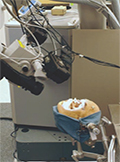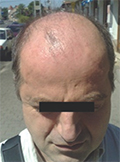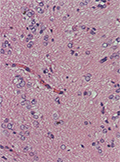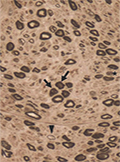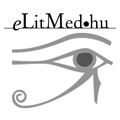The eLitMed.hu medical portal uses computer cookies for convenient operation. Detailed information can be found in the Cookie-policy.
Clinical Neuroscience - 2014;67(11-12)
Content
[Critical illness associated neuromuscular disorders - Keep them in mind]
[Neuromuscular disorders complicating sepsis and critical illness are not new and scarce phenomena yet they receive little attention in daily clinical practice. Critical illness polyneuropathy and myopathy affect nearly half of the patients with sepsis. The difficult weaning from the ventilator, the prolonged intensive care unit and hospital stay, the larger complication and mortality rate these disorders predispose to, put a large burden on the patient and the health care system. The aim of this review is to give an insight into the pathophysiological background, diagnostic possibilities and potential preventive and therapeutic measures in connection with these disorders to draw attention to their significance and underline the importance of preventive approach.]
[The interactive neuroanatomical simulation and practical application of frontotemporal transsylvian exposure in neurosurgery]
[Background and purpose - There is an increased need for new digital education tools in neurosurgical training. Illustrated textbooks offer anatomic and technical reference but do not substitute hands-on experience provided by surgery or cadaver dissection. Due to limited availability of cadaver dissections the need for development of simulation tools has been augmented. We explored simulation technology for producing virtual reality-like reconstructions of simulated surgical approaches on cadaver. Practical application of the simulation tool has been presented through frontotemporal transsylvian exposure. Methods - The dissections were performed on two cadaveric heads. Arteries and veins were prepared and injected with colorful silicon rubber. The heads were rigidly fixed in Mayfield headholder. A robotic microscope with two digital cameras in inverted cone method of image acquisition was used to capture images around a pivot point in several phases of dissections. Multilayered, high-resolution images have been built into interactive 4D environment by custom developed software. Results - We have developed the simulation module of the frontotemporal transsylvian approach. The virtual specimens can be rotated or tilted to any selected angles and examined from different surgical perspectives at any stage of dissections. Important surgical issues such as appropriate head positioning or surgical maneuvers to expose deep situated neuroanatomic structures can be simulated and studied by using the module. Conclusion - The simulation module of the frontotemporal transsylvian exposure helps to examine effect of head positioning on the visibility of deep situated neuroanatomic structures and study surgical maneuvers required to achieve optimal exposure of deep situated anatomic structures. The simulation program is a powerful tool to study issues of preoperative planning and well suited for neurosurgical training.]
[Hungarian experiences with levodopa/carbidopa intestinal gel in the treatment of advanced Parkinson’s disease]
[In the advanced Parkison’s disease (PD) the late complications of levodopa therapy have to be considered: motor and/or non-motor fluctuations with or without disturbing dyskinesias. The non-motor fluctuations often influence the quality of life (QoL) in a much more negative way compared with the motor symptoms. In the treatment of advanced PD there are several device-aided methods - deep brain stimulation, apomorphine pump, levodopa/carbidopa intestinal gel (LCIG ) - to improve the symptoms, the QoL, sometimes even in an individual, tailored custom form. The LCIG therapy was introduced in Hungary in 2011. Here we summarize the data of our patients: we have tested almost 60 patients and in 43 cases we have started this treatment. We analyze the duration of illness, levodopa therapy, motor and non-motor fluctuation of patients and present our experiences with the test phase and the chronic LCIG therapy via PEG/PEJ implantation. We paid attention to the surgery and device - depending side effects. Our experiences are similar to the international data. In patients selection „the right treatment, to the right patient, in the right time” is of importance.]
[Tailored cranioplasty using CAD-CAM technology]
[Objective - The majority of cranial defects are results of surgical intervention. The defect must be covered within resonable period of time usually after 4-6 week given the fact that the replacement of bone improve the brain circulation. Number of surgical techniques and materials are available to perform cranioplasty. Due to favorable properties we chosed ultra high molecular weight polyethylene as material. In this paper the authors show a procedure which allows tailored artificial bone replacement using state of art medical and engineering techniques. Methods - between 2004 and 2012, 19 patients were operated on cranial bone defect and a total of 22 3D custom- designed implants were implanted. The average age of patients was 35.4 years. In 12 patients we performed primary cranioplasty, while seven patients had the replacement at least once. Later the implants had to be removed due to infection or other causes (bone necrosis, fracture). All patients had native and bone- windowed 1 mm resolution CT. The 3D design was made using the original CT images and with design program. Computer controlled lathe was used to prepare a precise-fitting model. During surgery, the defect was exposed and the implant was fixed to normal bone using mini titanium plates and screws. All of our patients had control CT at 3, 6 and12 months after surgery and at the same time neurological examination. Results - Twenty-one polyethylene and one titanium implants were inserted. The average follow-up of the patients was 21.5 months, ranged from two to 96 months. We follow 12 patients (63.15%) more than one year. No intraoperative implant modifications had to be made. Each of the 22 implant exactly matched the bone defect proved by CT scan. No one of our patients reported aesthetic problems and we did not notice any kind of aesthetic complication. We had short term complication in three cases due to cranioplasty, subdural, epidural haemorrhage and skin defect. Conclusion - Polyethylene is in all respects suitable for primary and secondary cranioplasty. Combined with 3D CADCAM method excellent aesthetic and functional result was achieved. In our study no case of infection occured. Proper preoperative preparation is important.]
[From life events to symptoms of anxiety and depression: the role of dysfunctional attitudes and coping]
[The aim of the present study was a systematic path-analytical investigation between the effects of life events, dysfunctional attitudes and coping strategies in relation with the exhibited depressive and anxiety symptoms in patients with mental disorders. Methods - Self-report data of 234 patients from our outpatient psychotherapy unit were analyzed. Life events, dysfunctional attitudes, coping strategies as well as symptoms of anxiety and depression were assessed by self-administerd questionnaires. Statistical methods included structural equation modelling, which enables the estimation of the magnitude and strength of individual variables within an overarching casual model, thus yielding a complex view on the possible processes underlying the development of the clinical symptoms of anxiety and depression. Results - Our findings indicate that both the number of negative life events and their subjectively experienced intensity contributed to the increase of dysfunctional attitudes. The presence of dysfunctional attitudes decreased the use of problem-focused coping strategies and increased the use of emotion-focused coping strategies. The use of problem-focused coping decreased symptom occurrence and emotion-focused coping strategies increased the frequency of symptoms of anxiety and depression. Our findings suggest that dysfunctional need for achievement and perfectionism directly increase the probability of depressive symptom manifestation. The attitude of external locus of control showed a significant relationship with anxiety symptoms through emotion-focused coping strategies and directly as well. Conclusion - Restructuring dysfunctional attitudes and developing problem-focused coping strategies are an important part of psychotherapeutic interventions aiming to decrease anxiety and depressive symptoms.]
[Neurocognitive impairments of HIV infected individuals - Preliminary results of a national prevalence study in Hungary]
[Background and purpose - The outcome of HIV infection has dramatically improved due to the widespread use of combined antiretroviral therapy (cART). Opportunistic infections faded and internal and hemato-oncological diseases along with neurological conditions came to the forth. Present study is to evaluate neurocognitive performance of the Hungarian HIV infected individuals, at first in this setting. Patients and methods - We performed this cross-sectional pilot study within the frames of a national, single-center; prospective study on group of HIV infected patients, analyzing medical data and neurocognitive performance. Based on international recommendations visual memory, visuomotor coordination, non-verbal learning ability, executive functions and reaction time were tested by six domains of a computerized neuropsychological test battery (Vienna Test System). Results - Data of 59 enrolled HIV individuals were analysed; nine of whom were women (15%), median age 42.6 (IQR: 32.4-48.1) years. In 32.2% (n=19) of patients neurocognitive impairment was detected. Duration of infection and cART treatment time tended to be longer in impaired group (not significant). Lower CD4 cell count at the time of examination (p=0.047), psychiatric diseases other than depression (p=0.005) were found significantly associated with impairment; tertiary education qualification were more common (p=0.033) among non-affected patients. By correlation analysis age, infected time and duration of cART were significantly associated with motor deficit. Conclusion - HAND was detected in almost one third part of examined patients, which largely corresponds that in developed countries were observed. Duration of infection and of cART therapy associated motor deficit was found to be the most common impairment. This finding might be interpreted by direct effect of HIV, neurotoxicity of antiretrovirals and also by accelerated ageing of this population.]
[Symptomatic subependymomas of the ventricles. Review of twenty consecutive cases]
[Background and purpose - Intraventricular subependymomas are rare benign tumors, which are often misdiagnosed as ependymomas. To review the clinicopathological features of subependymomas. Patient selection and methods - Retrospective clinical analysis of intraventricular subependymomas and systematic review of histological slides operated on at our center between 1985 and 2005. Results - Twenty subependymomas presented at the median age of 50 years (range 19-77). Two (10%) were found in the third, three (15%) in the forth, and 15 in the lateral ventricles. There was male preponderance (12 vs. 8). Ataxia (n=13) and papilledema (n=7) were the most common clinical presentations. Fifteen patients underwent gross total resection, and five had subtotal resection. None of the cases showed mitotic figures, vascular endothelial proliferation or necrosis. Cell proliferation marker MIB-1 activity (percentage of positive staining tumor cells) ranged from 0 to 1.4% (mean 0.3). Two cases were treated with preoperative radiation therapy (50 Gy) before the CT era, three other patients received postoperative radiation therapy for tumors originally diagnosed histologically as low grade ependymomas. Three patients (15%) died of surgical complication between one and three months postoperatively, and three patients died of unrelated causes in eight, 26 and 110 months. Fifteen patients were alive without evidence of tumor recurrence at a median follow-up time of 10 years. Conclusion - Subependymomas are low-grade lesions and patients do well without adjuvant radiotherapy. Small samples from more cellular areas may be confused with low grade ependymomas, and unnecessary radiotherapy may follow. Recurrences, rapid growth rates should warrant histological review, as hypocellular areas of ependymomas may also be a source of confusion.]
[The modifying effect a PMP22 deletion in a family with Charcot-Marie-Tooth type 1 neuropathy due to an EGR2 mutation]
[Background - Mutations of both the PMP22 and EGR2 genes cause Charcot-Marie-Tooth (CMT) disease type 1. Deletion of the PMP22 gene, results in hereditary neuropathy with liability to pressure palsies. More publications exist about the interaction of PMP22 duplication and other CMTcausing gene mutations. In these cases the intrafamiliar discordant phenotypes draw the attention to the possible role of modifying genes. The gene-gene interactions between the PMP22 and EGR2 genes are not well understood. Case report - We report two brothers with late onset CMT1 due to a c. 1142 G>A (Arg381His) heterozygous substitution in the EGR2 gene. Additionally, the older brother with the less severe symptoms harbored the PMP22 gene deletion also. Conclusion - The coexistence of the two genetic alterations did not aggravate the clinical symptoms. Moreover, the PMP22 deletion appeared to have a beneficial modifying effect, thus implying potential gene-gene interaction of PMP22 and EGR2. PMP22 deletion may increase Schwann cells proliferation and compensate the dominant-negative effect of the Arg381His substitution in the EGR2 gene.]
[A rare paroxysmal movement disorder: Mixed type of paroxysmal dyskinesia]
[Paroxysmal dyskinesias are rare, heterogeneous group of disorders characterised by recurrent attacks of involuntary movements. The four classic categories of paroxysmal dyskinesias are kinesigenic, nonkinesigenic, exercise-induced and hypnogenic. There are some patients that do not fit in these four groups of paroxysmal dyskinesia and are termed as “mixed type”. We describe a 13-year-old girl who had features of both paroxysmal kinesigenic dyskinesia and paroxysmal nonkinesigenic dyskinesia that was misdiagnosed as refractory epilepsy. She improved substantially with a combination of carbamazepine and clonazepame. It is important to recognize the clinical presentation of paroxysmal dyskinesias and distinguish these movement disorders from other disorders, such as psychogenic disorders and epilepsia, for deciding the treatment and prognosis of the patients. This case highlights the importance of the recognition of a rare paroxysmal movement disorders.]
1.
Clinical Neuroscience
[Headache registry in Szeged: Experiences regarding to migraine patients]2.
Clinical Neuroscience
[The new target population of stroke awareness campaign: Kindergarten students ]3.
Clinical Neuroscience
Is there any difference in mortality rates of atrial fibrillation detected before or after ischemic stroke?4.
Clinical Neuroscience
Factors influencing the level of stigma in Parkinson’s disease in western Turkey5.
Clinical Neuroscience
[The effects of demographic and clinical factors on the severity of poststroke aphasia]1.
2.
Clinical Oncology
[Pancreatic cancer: ESMO Clinical Practice Guideline for diagnosis, treatment and follow-up]3.
Clinical Oncology
[Pharmacovigilance landscape – Lessons from the past and opportunities for future]4.
5.




